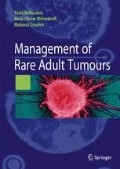Abstract
Medulloblastoma (M) is an aggressive posterior fossa tumour that probably originates from germinative neuroepithelial cells in the fourth ventricle (however, histogenesis is very controversial). Medulloblastoma accounts for 1% of all adult brain tumours and 25% of brain tumours in children. It is exceptional in patients aged over 16 years, while the median age of adult medulloblastoma is about 28 [1]. The most common revealing symptoms are: intra-cranial hypertension, cerebellar disorders and palsy of cranial nerves. In adults, the MRI findings show an homogeneous tumour predominantly located in the cerebellar hemisphere, poorly defined with weak contrast enhancement, with hypersignal flair and hypo-signal T1. Laterally located tumours are most common in adults compared to children (30% versus 7%). The WHO histological classification distinguishes 4 classical subtypes (classic M, extensive nodulary M, desmoplastic M and large cell M) and 2 rare subtypes (melanocytic M and medullomyoblastoma). The desmoplastic subtype is more frequent in adults than in children (40% versus 15%). Metastasis is more common in adults than in children: initial spinal or cerebral metastasis in about 30% of cases, cerebrospinal fluid involvement in about 30% of cases and metastasis outside the CNS (bone) in 5% of cases [1, 3, 7]. A specific TNM classification has been described by [3].
Access this chapter
Tax calculation will be finalised at checkout
Purchases are for personal use only
Preview
Unable to display preview. Download preview PDF.
Refrences
Abacioglu U, Uzel O, Sengoz M et al. (2002) Medulloblastoma in adults: treatment results and prognostic factors. Int J Radiation Oncol Biol Phys 54:855–60
Brandes AA, Paris MK (2004) Review of the prognostic factors in medulloblastoma of children and adults. Crit Rev Onco Hematol 50:121–8
Chang CH, Horton J, Schoenfeld D et al. (1983) Comparison of postoperative radiotherapy and combined postoperative radiotherapy and chemotherapy in the multidisciplinary management of malignant gliomas. A joint Radiation Therapy Oncology Group and Eastern Cooperative Oncology Group Study. Cancer 52: 997–1007
Delaney TF (2007) Clinical proton radiation therapy research at the Francis H Burr Proton Therapy Center. Technol Cancer Res Treat 6: 61–6
Hartsell WF, Guijar A, Heidemann RL et al. (1997) Patterns of failure in children with medulloblastoma: effects of preradiation chemotherapy. Int J Radiat Oncol Biol Phys 39: 15–24
Kortmann RD, Kuhl J, Timmerman B et al. (2000) Postoperative chemotherapy before radiotherapy as compared to immediate radiotherapy followed by maintenance chemotherapy in the treatment of medulloblastoma in childhood: results of the German prospective randomised trial HIT’ 91. Int J Radiat Oncol Biol Phys 46: 269–79
Padovani L, Sunyach MP, Perol D et al. (2007) Common strategy for adult and pediatric medulloblastoma: a multicenter series of 253 adults. Int J Radiat Oncol Biol Phys 68: 433–40
Parker W, Filion E, Roberge D et al. (2007) Intensity-modulated radiotherapy for craniospinal irradiation: target volume considerations, dose constraints, and competing risks. Int J Radiat Oncol Biol Phys 69: 251–7
Paulino AC, Wen BC, Mayr NA et al. (2003) Protracted radiotherapy treatment duration in medulloblastoma. Am J Clin Oncol 26: 55–9
Zeltzer PM, Boyett JM, Finlay JL et al. (1999) Metastasis stage, adjuvant treatment, and residual tumor are prognostic factors for medulloblastoma in children: conclusions from the Children’s Cancer Group 921 randomized phase III study. J Clin Oncol 17: 832–45
Editor information
Editors and Affiliations
Rights and permissions
Copyright information
© 2009 Springer-Verlag France, Paris
About this chapter
Cite this chapter
Penel, N., Ferte, C., Rhun, É.L., Belkacémi, Y. (2009). Treatment of Medulloblastoma in adults. In: Belkacémi, Y., Mirimanoff, RO., Ozsahin, M. (eds) Management of Rare Adult Tumours. Springer, Paris. https://doi.org/10.1007/978-2-287-92246-6_4
Download citation
DOI: https://doi.org/10.1007/978-2-287-92246-6_4
Publisher Name: Springer, Paris
Print ISBN: 978-2-287-92245-9
Online ISBN: 978-2-287-92246-6
eBook Packages: MedicineMedicine (R0)

